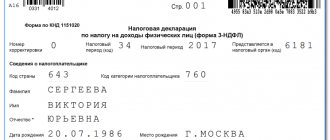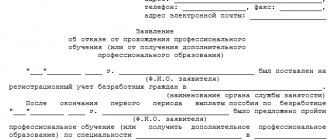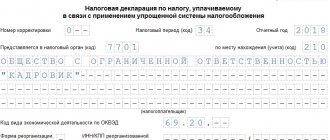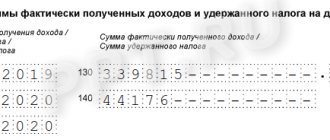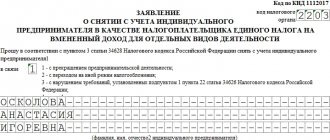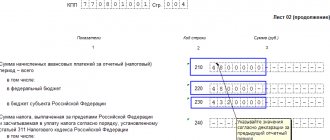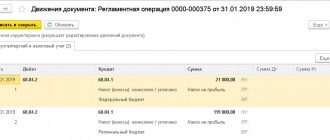Who must submit a water tax return and when?
All water tax payers, that is, legal entities and entrepreneurs who use water bodies in accordance with obtained licenses , are required to submit quarterly reports.
The last day for filing a declaration is the 20th day of the month following the end of the reporting quarter . If the deadline falls on a weekend, the deadline is moved to the next working day. For the quarter of 2018, you need to report on this tax:
- until April 20;
- until July 20;
- until October 22;
- until January 21, 2020.
The tax payment deadline corresponds to the tax return filing deadline.
Where to submit the report
You need to report water tax to the Federal Tax Service at the location of the taxable object . The exception is for the largest taxpayers - they must submit a declaration to the Federal Tax Service where they are registered.
Water tax payers who use facilities located on the territory of several municipalities, but in the same region, have a choice. They can submit a declaration:
- To the Federal Tax Service at its location in this region.
- In agreement with the regional Tax Service Department, to one of the inspectorates at the place of use of water bodies.
Report form
The current declaration was approved by order of the Federal Tax Service dated November 9, 2015 N ММВ-7-3/ [email protected] The same document also approved the procedure for filling it out (hereinafter referred to as the Procedure).
The declaration includes a title page, a sheet of information about an individual who is not an individual entrepreneur, as well as sections 1 and 2. The latter has two subsections that taxpayers fill out depending on the order in which they use the water body (with water intake from it or without a fence).
The declaration is filled out in terms of OKTMO codes , that is, in relation to the amount of taxes payable in the corresponding municipality.
Filling procedure
Title page
On the title page the taxpayer indicates:
- TIN . 10 digits for legal entities, 12 for individuals and individual entrepreneurs.
- Checkpoint . Code assigned by the tax authority where the declaration is submitted.
- Correction number . If the declaration for the specified quarter is submitted for the first time, “0—” is entered. When submitting an updated declaration, the correction number is entered: “1—”, “2—” and so on.
- Tax period (code). Filled out in accordance with Appendix No. 1 to the Procedure. The taxpayer must select one of the codes:
- 21 - first quarter;
- 22 - second quarter;
- 23 - third quarter;
- 24 - fourth quarter;
- for reorganized or liquidated organizations: 51 - first quarter;
- 54 - second quarter;
- 55 - third quarter;
- 56 - fourth quarter.
- Reporting year. The year to which the reporting quarter relates is indicated.
- Tax authority code. It is necessary to indicate the code of the authority to which the declaration is submitted. For example, code 7722 is deciphered as follows: 77 is the region, that is, the city of Moscow, 22 is the number of the tax authority. That is, code 7722 corresponds to Federal Tax Service Inspectorate No. 22 for the city of Moscow.
- By location (registration) (code). The code from Appendix No. 1 to the Procedure is indicated:
- 213 - at the place of registration of the largest taxpayer;
- 255 - at the location of the water body;
- 250 - at the place of registration of taxpayers when executing production sharing agreements.
- Taxpayer. The full name of the organization, including its legal form, or the last name, first name and patronymic of an individual entrepreneur shall be indicated.
- Code of the type of economic activity. The code is indicated in accordance with OKVED.
- Block for reorganized companies. It indicates the TIN/KPP of the organization, the code of the reorganization form from Appendix No. 1 to the Procedure.
- contact telephone number . Indicated together with the code without spaces or other symbols between the numbers.
Upper part of the title page
At the bottom of the title page, the taxpayer must confirm the accuracy and completeness of the data specified in the report. The part is filled in as follows:
- Code 1 is indicated if the taxpayer signs the declaration, code 2 if the report is signed by his representative.
- In the following lines, the last name, first name and patronymic of the head of the taxpayer organization are indicated line by line. If the declaration is submitted by an individual entrepreneur, there is no need to duplicate his full name.
- If the declaration is signed by a representative of the taxpayer , then his last name, first name and patronymic are indicated. If such a representative is an organization, then the full name of its head is indicated, and the name of the representative organization is indicated in the following lines.
- If the declaration is signed by a representative, an individual or a legal entity, the last two lines indicate information about the document confirming his authority .
Bottom of title page
Information about an individual who is not an individual entrepreneur
This section is filled out only by individuals who are not entrepreneurs recognized as water tax payers in accordance with Article 333.8 of the Tax Code of the Russian Federation.
Such persons indicate their full name, date of birth, code of country of citizenship, information about the identity document (type of document, its series and number, information about issue), taxpayer status, address of residence in the Russian Federation.
Filling out this part of the declaration is not difficult. Let's mention just a few details:
- The code of the country of citizenship is indicated in accordance with the all-Russian classifier of countries of the world. For Russia this is code 643.
- The document type code is taken from Appendix No. 2 to the Procedure. The passport of a citizen of the Russian Federation corresponds to code 21.
- Taxpayer status . Residents indicate code 1, non-residents - 2.
- The region code must be taken from Appendix No. 3 to the Procedure.
This sheet is filled out by individuals (not individual entrepreneurs)
Section 2
Section 2 calculates the water tax base and its amount. This section should be completed before Section 1, since the latter contains the results of the calculations that are carried out in Section 2.
Subsection 2.1
Subsection 2.1 serves to calculate the base and amount of tax for those taxpayers who withdraw water from a water body. Line by line this section is filled out like this:
- Line 010. The budget classification code is indicated, according to which the tax will be credited to the budget.
- Line 020. OKTMO code at the location of the water use facility.
- Line 030. Name of the water body. If this object belongs to groundwater, the number of the artesian well is indicated.
- Line 040. Information about the taxpayer’s licenses is reflected. You must indicate the series, number and type of license, separating them with the sign “;”.
- Line 060. The water use code from the range 11011–13140 is indicated, which must be taken from Appendix No. 4 to the Procedure. The exception is the water bodies of Crimea and Sevastopol - codes 50091 and 50092 are intended for them.
- Line 060. The total volume of water in thousand cubic meters that was taken from this facility for the tax period for a specific water use code. The indicator is calculated as follows: Line 70 + Line 100.
- Line 070. Reflects the actual volume of water taken for purposes not recognized as an object of taxation under paragraph 2 of Article 3.9 of the Tax Code of the Russian Federation.
- Line 080. Water intake purpose code. Taken from Appendix No. 5 to the Order.
- Line 090. The limit value of the water use indicator in thousand cubic meters, which is indicated in the license for a given facility and the purpose of water use.
- Line 100. The total volume of water that was taken from this facility during the quarter for a specific water use code and purpose of withdrawal, subject to tax. The indicator for this line is calculated as follows: Line 101 + Line 102.
- Line 101. The volume of water withdrawn from sources within the established limit.
- Line 102. The volume of water taken from the source in excess of the limit.
- Line 110. The rate established for calculating the tax for the volume of water withdrawn within the limit (subclause 1 of clause 1 of Article 333.12 of the Tax Code of the Russian Federation).
- Line 120. The rate established for calculating tax above the limit (clause 2 of Article 333.12 of the Tax Code of the Russian Federation).
Note! If the declaration is filled out by an individual who is not an individual entrepreneur, lines 110 and 120 indicate the rates from paragraph 3 of Article 333.12 of the Tax Code of the Russian Federation.
- Line 130. Coefficient from clause 1.1 of Article 333.12 of the Tax Code of the Russian Federation. In 2020 it is 1.75.
- Line 140. Coefficient 1.1 (clause 4 of Article 333.12 of the Tax Code of the Russian Federation). The coefficient is applied if the water source does not have a means of measuring the volume of water taken.
- Line 150. Coefficient 10 (clause 5 of Article 333.12 of the Tax Code of the Russian Federation). Indicated if groundwater is extracted for the purpose of selling it after processing and packaging. Please note! If the coefficients mentioned in lines 130–150 are not applied by the taxpayer, dashes are placed instead.
- Line 160. Indicate the amount of tax payable to the budget, calculated using the formula: Line 101 × Line 110 × Line 130 × Line 140 × Line 150 + Line 102 × Line 110 × Line 130 × Line 140 × Line 150 .
Section 2.1 form
Subsection 2.2
Subsection 2.2 calculates the tax base and amount if the user does not withdraw water. This part of the declaration is filled out by taxpayers who:
- use the water areas of water bodies;
- use water bodies without water intake for hydropower;
- use objects for wood rafting.
Subsection 2.2 should be completed separately for each type of use, water body and license. If different tax rates are applied, then the section for each rate is also filled out separately.
Next, let's look at filling out this section line by line:
- Line 010. Reflects the BCC, according to which the tax should be credited to the budget.
- Line 020. OKTMO code at the location of the water use facility.
- Line 030. Name of the object - lake, river, etc.
- Line 040. Information about licenses. Through the sign ";" the series, number and type of license are indicated.
- Line 050. Information about the agreement for the use of the water body is reflected.
- Line 060. Water use code from Appendix No. 4 to the Procedure.
- Line 070. Filled in if Line 060 contains a code in the range 21010–22140. The tax base is reflected, defined as the area of water in square kilometers. The area is taken from the license, and if it is missing, from the technical and design documentation.
- Line 080. Filled in if Line 060 contains a code in the range 30100–32100. The amount of electricity produced is indicated in thousand kilowatt-hours.
- Line 090. Filled in when reflected on Line 060 of the code in the range 40100–41200. The volume of wood rafted during the tax period is reflected in thousand cubic meters.
- Line 100. Filled in when reflected on Line 060 of the code in the range 40100–41200. The distance of timber rafting is reflected in kilometers.
- Line 110. The tax rate from paragraph 1 of Article 333.12 of the Tax Code of the Russian Federation is indicated.
- Line 120. The coefficient established in paragraph 1.1 of Article 333.12 of the Tax Code of the Russian Federation. In 2020, the coefficient is 1.75.
- Line 130. The amount of tax on a water body or license subject to payment to the budget. It is calculated as follows: If line 060 contains a code in the range 21010–22140 - Line 070 × Line 110 × Line 120 / 4.
- If line 060 contains a code in the range 30100–32100 - Line 080 × Line 110 × Line 120.
- If line 060 contains a code in the range 40100–41200 - Line 090 × Line 100 × Line 110 × Line 120 / 100.
Examples of filling lines 60–100:
- The taxpayer uses the water area of the water body . In line 060 it should reflect the water use code in the range 21010–22140. In lines 080–100 of section 2.2, this taxpayer will put a dash.
- The taxpayer uses water bodies for hydroelectric power . According to Line 060, it should reflect the water use code in the range 30100–32100. In lines 070, 090 and 100 of section 2.2, he must put a dash.
- The taxpayer uses water bodies for timber rafting . In line 060 it reflects the code in the range 40100–41200, in lines 070 and 080 dashes are placed.
Section 2.2 form
Section 1
This section reflects the amount of tax that must be paid to the budget. The section is filled in according to the location of the taxable object.
Line 010 indicates the budget classification code by which the tax is credited to the budget. Next in the section there are blocks from lines 020–030, which indicate:
- In line 020 - the code of the municipality where the water intake item for which the tax is paid is located.
- In line 030 - the amount of tax for all types of water use according to the specified OKTMO. To determine it, you need to add up the tax amounts reflected for all types of water use in subsections of the declaration 2.1 and 2.2 with the corresponding OKTMO and KBK codes.
The correctness of filling out the declaration can be checked using the control ratios from the letter of the Federal Tax Service dated September 7, 2016 No. SD-4-3/16671.
Section 1 form
Filling out the section on water intake
The calculation of water tax on water withdrawal from water sources depends on the water use limit established in the license (water use agreement).
The exception is the withdrawal of water for water supply to the population, the volume of which is not limited. Therefore, in subsection 2.1 the quarterly value of the water use limit is indicated, and the total volume of water withdrawn is divided into two values: within the limit and above it.
Accordingly, two tax rates are given. The rate for volume within the limit is determined according to subparagraph. 1 clause 1 art. 333.12 of the Tax Code of the Russian Federation, depending on the location of the water body and its type (surface or underground). For 2020, in accordance with clause 1.1 of Art. 333.12 of the Tax Code of the Russian Federation, multiplied by an increasing factor of 1.15. The rate for above-limit volume is obtained by a 5-fold increase in the rate calculated for volume within the limit (clause 2 of Article 333.12 of the Tax Code of the Russian Federation).
Current legislative changes on the water tax are discussed in the material “Changes to the Tax Code of the Russian Federation on water tax in 2015.”
The tax amounts for each volume are calculated by multiplying the corresponding volume by the corresponding rate. The result of adding these two amounts is reflected in the final line of subsection 2.1.
If water is taken without using means of measuring its volume, then another increasing factor is applied to the rate - 1.1 (Clause 4 of Article 333.12 of the Tax Code of the Russian Federation). And if groundwater is withdrawn for the purpose of its further sale, then a 10-fold multiplying factor is used for the rate.
If there are reasons to use several coefficients, they are all applied by multiplication. In the declaration, in the “Bet” line, the final result of multiplying the original bet by all used odds, rounded to whole rubles, is shown.
When subsection 2.1 is filled in based on the results of water selection for water supply to the population, then the rate established by clause 3 of Art. is used to calculate the tax. 333.12 of the Tax Code of the Russian Federation for the corresponding year. Increasing coefficients are not applied to it.
Fines
There are penalties for failure to submit or late submission of a water tax return. In accordance with paragraph 1 of Article 119 of the Tax Code , for violation of the deadline, a fine of 5% of the tax amount will be imposed for each full or partial month of delay. The minimum fine will be 1,000 rubles , the maximum - 30% of the tax amount .
blocking of a current account can be applied as a sanction . Such a decision may be made if the declaration is not received within 10 days after the deadline for acceptance.
Method of submitting the declaration
https://www.youtube.com/watch?v=3S1Rri-8dRA
If the average number of employees of an organization for the previous calendar year exceeded 100 people, then the organization is obliged to submit a water tax declaration in electronic form (clause 3 of Article 80 of the Tax Code of the Russian Federation ). If the average number of employees does not exceed this value, then the declaration can be submitted on paper.
Example of tax calculation and filling out a declaration
Input data:
- source - artesian well near the Kuban River basin;
- the location of the water body is the North Caucasus Federal District;
- type of use - water intake;
- the volume of water withdrawn in the reporting period is 150,000 cubic meters, including: 100,000 cubic meters - within the limit;
- 50 000 cubic meters - over the limit;
Tax amount calculation:
- Within the limit - 100 (thousand cubic meters) × 570 (rubles per 1 thousand cubic meters) × 1.52 = 86,640 rubles.
- Over the limit - 50 (thousand cubic meters) × 2,850 (rubles per 1 thousand cubic meters) × 1.52 = 216,600 rubles.
- Total tax amount: 86,640 + 216,600 = 303,240 rubles.
The taxpayer must fill out sections 1 and 2.1 as follows:
How to calculate water tax
For all types of water use, the tax is calculated as the product of the tax base and the tax rate, adjusted for increasing factors. The calculation is made in the water tax declaration.
Let's look at an example
Breeze LLC extracts water from an artesian well, equipped with metering devices and located in the Central Economic Region (other river basin). The water use limit, according to the license, is 100 thousand cubic meters. m. In the 1st quarter of 2020 the volume of water intake was 110 thousand cubic meters. m, of which 10 thousand cubic meters. m – over-limit.
For water intake facilities, the water tax is calculated in subsection 2.1 of the declaration. Within the limit, 100 thousand cubic meters were taken. m of water. The tax rate is 336 rubles. for 1 thousand cubic meters m (clause 1 of Article 333.12 of the Tax Code of the Russian Federation), the increasing coefficient in 2020 is 1.52:
For water intake in excess of the limit, the tax is calculated at a 5-fold rate, and the tax amount for the excess volume is equal to:
Let’s assume that Breeze LLC has another water use facility: a lake in the Central Economic Region. According to the license, the area of the facility is 3 square meters. km. Let's calculate the tax in section 2.2 of the declaration.
Tax rate – 30.84 thousand rubles. for 1 sq. km of water area, it is annual (clause 2 of Article 333.12 of the Tax Code of the Russian Federation), therefore the resulting tax amount must be divided by 4:
An example of filling out a water tax return:
Normative base
- Order of the Federal Tax Service dated November 9, 2015 No. ММВ-7-3/ [email protected] “On approval of the form of the tax return for water tax, the procedure for filling it out, as well as the format for submitting the tax return for water tax in electronic form.”
- Tax Code, Chapter 25.2. Water tax.
- Letter of the Federal Tax Service dated September 7, 2020 No. SD-4-3/ [email protected] “On approval of control ratios of the water tax declaration.”
Find out when you can file a single simplified return instead of a water tax report and some other forms.
Which form to use
The water tax return form valid in 2020 was approved by order of the Federal Tax Service of Russia dated November 9, 2020 No. ММВ-7-3/497. Its form according to KND is 1151072.
This declaration form is used from reporting for the first quarter of 2016.
The current water tax declaration form for 2020 includes the following parts:
- title page;
- information about an individual (not an individual entrepreneur);
- Section No. 1 – the amount of tax to be deducted to the budget;
- Section No. 2 – calculation of the tax base and tax amount.
Note that the second section has 2 subsections:
- 2.1 – calculation of the base and amount of water tax when taking water from a water body;
- 2.2 – calculation of the base and amount of water tax when using the facility (without water intake).

